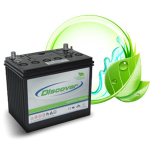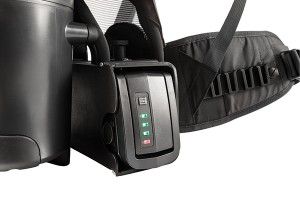How Battery Technology is Changing Cleaning Productivity
Chances are good your janitorial closet includes battery-powered equipment. In fact, smaller, cordless equipment is becoming becoming more and more common in the cleaning industry.
In the past, batteries typically were used only in larger pieces of equipment, like automatic scrubbers, because the technology at the time for smaller batteries was expensive and they typically had short run times. Thanks to advances in technology, however, they are now smaller, lighter, run longer, and cost much less, finally making them a practical alternative to small, plug-and-go corded machines.
A good example of a small battery powered unit that offers several benefits is the battery powered backpack vacuum, which is one of the most sought after tools that buyers today are looking to add to their cleaning equipment fleet. These backpack vacuums improve building safety by reducing trip-and-fall accidents associated with cords, and boost worker productivity by eliminating the need to frequently plug, unplug, and re-plug in a machine.
Battery technology continues to evolve, and the frequent changes can confuse buyers. Today, we’re examining the pros and cons of the most popular types of floor-machine batteries.
WET-CELL
Known as wet-cell, flooded, or lead-acid batteries, this is the oldest and most common type of battery used in professional cleaning equipment. Similar to those used in cars, this deep-cycle battery gets its charge from within the battery from an electrolyte that is about 65 percent water and 35 percent sulfuric acid.
 “Everyone knows wet batteries,” says Dan Frimml, Tornado’s technical services manager. “For people who want what they’ve always used and counted on, lead-acid batteries are right in their comfort zone and do a very good job when well maintained.” However, these types of batteries do need to be properly maintained to operate effectively. If not, which can happen in more cases than you would think for various reasons, these batteries can need to be replaced at a higher rate than they normally would need to be.
“Everyone knows wet batteries,” says Dan Frimml, Tornado’s technical services manager. “For people who want what they’ve always used and counted on, lead-acid batteries are right in their comfort zone and do a very good job when well maintained.” However, these types of batteries do need to be properly maintained to operate effectively. If not, which can happen in more cases than you would think for various reasons, these batteries can need to be replaced at a higher rate than they normally would need to be.
Wet-cell is the most affordable type of battery, but also requires the most maintenance.
GEL
Gel batteries have been around for several decades. They have the same electrolyte as wet-cell, but it is suspended in a silica type gel form. The batteries are completely sealed and are called “maintenance free.”
While gel batteries are inherently safer than wet cell batteries, they are not always particularly well suited for janitorial equipment.
“Gel batteries in general do not offer the same power capacity as would the same physical size AGM battery, so run times can sometimes be an issue,” Frimml says. “In addition, the gel charge profile is very important when charging a gel cell battery and if it isn’t charged correctly, the battery can suffer premature failure.”
AGM
In the last decade, manufacturers introduced the absorbed glass mat (AGM) battery. As the name implies, the battery’s electrolyte is absorbed into a glass mat. It’s a “maintenance-free” battery in a completely sealed system, which is becoming more popular as many regulated industries are requiring this type of technology.
“As a wet-lead battery is charged, it releases some amount of gas and the required maintenance can be hazardous to operators if not done properly. Because of the potential venting and maintenance hazards, many government municipalities are requiring the use of AGM or sealed maintenance free batteries,” Frimml says. “Being sealed, AGM doesn’t off-gas or require regular maintenance, which is causing a bigger demand.”
Although more expensive than a wet-cell battery, AGM is lower maintenance.
LITHIUM
The newest type of battery making its way into the jan/san industry is lithium.
 Lithium type batteries have been extremely popular in electronics for years, but cleaning equipment manufacturers only recently began using the technology. They are significantly more expensive than AGM, but have a comparable lifespan. The biggest advantage is their ability to be used in small equipment, which has the potential to make workers more productive.
Lithium type batteries have been extremely popular in electronics for years, but cleaning equipment manufacturers only recently began using the technology. They are significantly more expensive than AGM, but have a comparable lifespan. The biggest advantage is their ability to be used in small equipment, which has the potential to make workers more productive.
“We’re using lithium-ion batteries in our Pac-Vac Roam, backpack vacuum, and Lithium-Iron batteries in our BR 13/1 BAT compact scrubber, and the technology is exciting,” Frimml says. “Over time we’ll see more benefits from this type of battery as they’re incorporated into a variety of different types of cleaning equipment.”
WET-CELL VS. AGM
For now, buyers of larger janitorial equipment most often choose between wet-cell and AGM batteries. Many BSCs or housekeeping managers make their decision based on price tag.
“People are looking at initial outlay, but you can get the wrong battery when your decision is solely cost driven.”
Wet-cell (or flooded) batteries cost about half as much as AGM batteries and typically have a similar or slightly shorter lifespan. They must be the obvious best choice, right? Not always. For example, anyone working in a regulated industry may already or soon be required to use a sealed battery like AGM.
Another important consideration is maintenance. To achieve maximum lifespan from an AGM battery, workers must charge the machine after each use, and regularly clean the battery with baking soda and water.
Flooded batteries require those same efforts and more. They must be “watered” after charging, making sure distilled water is added to keep the electrolyte level above the plates and the vent caps tightened before use.
“If you slack off on maintenance of wet-cell batteries, you’ll cause battery degradation and can cut the lifespan in half or more.”
On larger pieces of equipment, facility managers and BSCs with high turnover or unconscientious workers may ultimately get more for their money with AGM. If your staff excels at regular maintenance, however, wet-cell batteries are likely the more economical choice.
Increase Profits & Productivity with Your Equipment
Tornado Industries does more then sell equipment. We help solve facility cleaning challenges. Let’s talk about your cleaning challenges in person.

